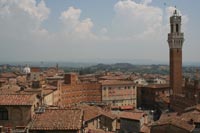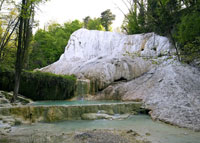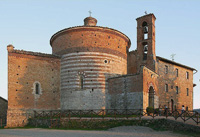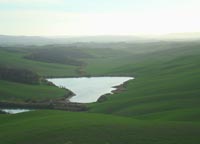| |
|
A number of da Sellaio's paintings for decorative chests (Italian: cassoni) survive in collections, such as his Story of Cupid and Psyche commissioned for a 15th Century Florentine marriage and depicting the ancient romance of the marriage of the mortal princess, Psyche, to the god of love, Cupid. He executed another wedding cassone, The Nerli Cassone, in collaboration with Zanobi di Domenico and Biagio d'Antonio in 1472. His piece now in the Uffizi Gallery, The Banquet of Ahasuerus, was also painted with two other panels, including Esther before Ahasuerus (Museum of Fine Arts, Budapest) for a cassoni.
Da Sellaio's small devotional pieces were well known, several of which depicted Saint Jerome and Saint John the Baptist. He also painted religious works for the church of San Lucia dei Magnoli and the church of San Frediano, both in Florence.
|
Jacopo del Sellaio (1441-1493) | Story of Cupid and Psyche
|
 |
Jacopo del Sellaio (1441-1493), Story of Cupid and Psyche, The Fitzwilliam Museum, Cambrdge University
|
| The two paintings (Fitzwilliam Museum) from a wooden marriage chest painted by Jacopo del Sellaio [3] are describing the myth of Cupid and Venus, and serve as an interesting reference to Botticelli's collage. Vasari describes both Sellaio and Botticelli as fellow pupils in the workshop of Fra Filippo Lippi, which makes a comparison particularly interesting. If we are to believe in the established dating of the artworks, then Sellaio executed the paintings some decade before Botticelli, even though he is usually considered as heavily influenced by Botticelli's work. Jacopo del Sellaio painted at least fifteen distinct episodes of the myth on two panels at the different sides of a marriage chest. The difference between the compositions of two painters is obvious: Sellaio is primarily describing the story as told by the classics whereas Botticelli is more mystical, more valuable are the subtle levels of an intuitive apprehension of the story than an appropriate description of narration. However, more interesting is a purely formal comparison, which enhances some previously drawn conclusions about the nature of Botticelli's inspiration considering the compound image of the Birth of Venus and La Primavera. |
|
|
| |
|
|
The Morelli-Nerli Chests
|
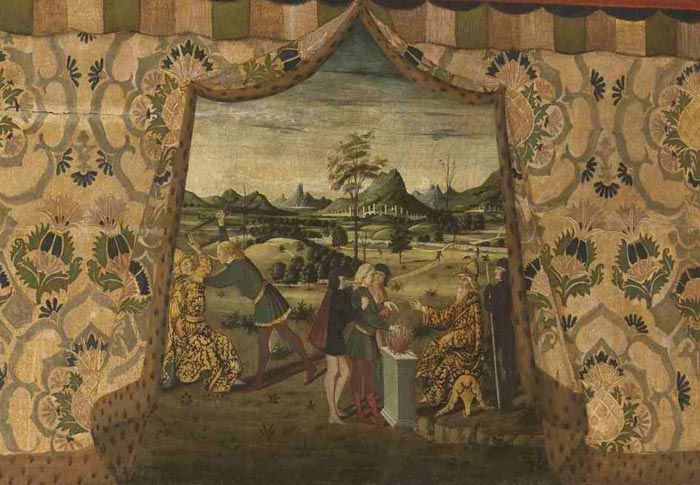 |
Biagio d'Antonio, Jacopo del Sellaio, and Zanobi di Domenico, backboard detail of the Nerli Cassone
|
| |
|
|
|
|
|
|
| |
|
The Morelli-Nerli Chests (ca. 1472), the only pair known to have survived intact and complete with their original highly decorated spalliere or backboards. These bridal receptacles are important examples of Renaissance furniture and provide fascinating insight into the family life and values of wealthy Renaissance Florentines.
The chests were commissioned in 1472 by Lorenzo di Matteo Morelli to mark the occasion of his marriage to Vaggia di Tanai di Francesco di Nerli. They were used to store precious items, including clothes and textiles.
In the 15th century a wedding was in most cases little more than a contract between two prominent families intended to combine their wealth, power and prestige. It was not about love. If love subsequently developed between the two parties, this was a bonus.
Marriage was an expensive business. When Lorenzo made his marriage preparations he kept records of his expenditures which still survive. In My expenses when I took my wife home (ca. 1471/2) he listed purchases and home refurbishments. By far the most important and expensive items was a pair of lavishly gilded and decorated wedding chests. Very few could read or write at this time, so decoration was chosen carefully to provide education and entertainment. Lorenzo's chest shows Camillus defeating the Gauls on the front panel and Horatius Cocles ("Horatius the one-eyed") defending the bridge against the Etruscans on the backboard. Viaggia's chest illustrates Camillus and the Roman army besieging the town of Falerii on the front panel and the Roman Mucius Scaevola attempting to assassinate his enemy, King Lars Porsenna, on the backboard.
The chests and their backboards were fabricated by the Italian woodworker Zanobi di Domenico, (act. ca. 1472). They were gilded and decorated by Biagio di Antonio (1446-1516) and Jacopo del Sellaio (ca.1442-1493).
Art in Tuscany | Courtauld Gallery Vodcast: Morelli Cassone, 1472 |
|
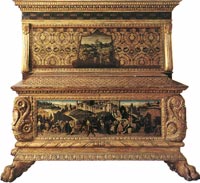
Jacopo del Sellaio, Nerli Cassone |
|
|
|
|
| |
|
| |
|
Jacopo del Sellaio
Triumph of Love |
|
|
|
|
| |
|
| Triumph of Chastity, inspired by 'Triumphs' by Petrarch (1304-74) (oil on panel) (detail of 194158)" by Jacopo del Sellaio; Location: Museo Bandini, Fiesole |
|
Jacopo del Sellaio
Triumph of Chastity |
|
|
|
|
| |
|
| |
|
Jacopo del Sellaio
Triumph of Time |
|
|
|
|
| |
|
|
|
|
|
|
|
|
| |
|
| |
|
„Triumph of Eternity“
Art Print by Jacopo del Sellaio
|
| |
|
|
| |
|
Jacopo del Sellaio
Banchetto di Assuero
Firenze, Galleria degli Uffizi |
|
|
|
|
| |
|
| |
|
|
| |
|
|
| |
|
|
| |
|
|
| |
|
|
| |
|
|
|
|
| |
|

Cristelle L. Baskins, Cassone Painting, Humanism and Gender in Early Modern Italy, Cambridge University Press (November 13, 1998).
Overlooked in traditional studies of Italian art, cassone painting was nonetheless a popular genre in Early Renaissance Tuscany. In this study, Cristelle Baskins questions the traditional readings of these decorated chests as merely didactic or moralizing. She argues that the pieces performed an important role in the socialization and gender formation of women during the Renaissance. She demonstrates that cassone, which invariably depict exemplary women from classical mythology, invited a range of responses, ranging from coercion to pleasure.
Cristelle Baskins, The Triumph of Marriage: Painted Cassoni of the Renaissance, Boston’s Isabella Stewart Gardner Museum, Periscope, 2008.
The Triumph of Marriage is the show catalogue of an art exhibition jointly curated by the Isabella Stewart Gardner Museum in Boston and the John and Mable Ringling Museum of Art in Sarasota.
Cassoni is the Italian word for the chests, painted with scenes from myth and literature, central to upper-class weddings of the 15th century. Little known today, cassoni deserve recognition as masterworks of the Renaissance. Botticelli, Pesellino and other superlative artists painted them, and they are precious early examples of the mythopoetic subjects that would form the core of European art until the 20th century. The essays in this book shed new light on the meaning of cassoni through informative discussions of Renaissance wedding rituals, male-female relations and daily domestic life. A catalogue section on cassoni in the exhibition that this book accompanies provides a unique guide to the stories of love, marriage and politics depicted on these sumptuous objects.
In addition to the Triumph of Marriage, other exhibitions on Renaissance marriage include: the Metropolitan Museum of Art’s Art and Love in Renaissance Italy (November 18, 2008–February 16, 2009); and the Peabody Essex Museum’s Wedded Bliss, The
Marriage of Art and Ceremony and the Bowdoin College Museum of Art’s recent Beauty and Duty: The Art and Business of Renaissance Marriage.
Ms. Jacqueline Marie Musacchio Ph.D. (Author), Art, Marriage, and Family in the Florentine Renaissance Palace, Yale University Press (February 24, 2009).
Jacqueline Marie Musacchio is associate professor of art at Wellesley College. She is the author of The Art and Ritual of Childbirth in Renaissance Italy (Yale). In Renaissance Italy, middle- and upper-class families spent enormous amounts on marriages that were intended to establish or consolidate the status and lineage of one or both of the respective families.
Art, Marriage, and Family in the Florentine Renaissance Palace, explores the social and economic background to marriage in Renaissance Florence and discusses the objects—paintings, sculptures, furniture, jewelry, clothing, and household items—associated with marriage and ongoing family life. By analyzing urban palaces and their furnishings, Jacqueline Marie Musacchio shows how families interacted with art on a daily basis. This began at marriage, when the bride brought a dowry and the groom provided the home and its furnishings. It continued with the accumulation of objects during the marriage and the birth of children. And it ended with the redistribution of these same objects at death. Through the examination of art, documents, literature, and more, this lively book traces the life cycle of the Florentine Renaissance family through the art and objects that surrounded them in their home.
Musacchio, Jacqueline Marie. "The Medici-Tornabuoni Desco da Parto in Context." Metropolitan Museum Journal, Vol. 33 (1998) | PDF
Virtu' d'Amore or Nuptial Art Exhibit, at La Galleria dell'Accademia in Florence
Galleria dell'Accademia, Florence | The virtues of love | Nuptial painting in XV century Florence
The bedroom was the fulcrum of the Renaissance home: the most intimate and protected place where the wedding was consumed, children were born, and one died. Spalliere/headboards like the so-called Cassone Adimari of the Galleria dell'Accademia, which occasions the exhibition, and the historiated panels of chests are extraordinary testimonies of the Florentine Renaissance home, high fashion, the celebration of festivities, the rituality that accompanied marriage, from engagement to the wife's entrance into her husband's house. Moreover, with the stories depicted, "nuptial painting" served the fundamental function of conveying messages of warning and encouragement to a couple to adopt a conduct considered as exemplary. This aspect helps us today to focus in on a mainstay of fifteenth-century Florentine culture: the role of the family and those of the husband and wife. Drawing on classical mythology, the Bible, historical episodes and contemporary literature, all of the facets of love are depicted, along with the ensuing duties: from love triumphant over adverse circumstances (The Marriage of Thetis and Peleus), to the virtues of obedience and abnegation that the woman must pursue (The Legend of Griselda from Boccaccio's Decameron), to the courage of the heroines Lucretia and Virginia, who choose death as source of redemption. An entire section illustrates the harmful consequences of love as sexual beguilement capable of totally subduing a man's will. We must not forget, however, that marriage meant first and foremost to give life to new progeny and perpetuate the family. Towards this end, the last section of the exhibition is dedicated to family pride, asserted in stories that recount the foundation of famous families like those of Aeneas and David or that, following the texts of Petrarch, celebrate the Triumphs of Fame, Time and Eternity. These images could also be painted on deschi da parto (birth salvers), which were tondos painted on both sides, offered as ceremonial gifts to women of the upper classes who had just given birth. A particularly famous one is the desco da parto realised on the occasion of the birth of Lorenzo the Magnificent (Triumph of Fame, New York, Metropolitan Museum). Finally, the exhibits feature works by illustrious painters like Botticelli (Story of Virginia Romana, Bergamo, Accademia Carrara), Filippino Lippi (Story of Lucretia, Florence, Galleria Palatina), and Pesellino (Stories of Susanna, Avignon, Musée du Petit Palais), which open an extraordinary view onto the Florentine workshops engaged in the production of these objects that enjoyed their greatest fortune precisely in the fifteenth century. The exhibition has been organised in collaboration with the Museo Horne of Florence which will present an itinerary valorising a consistent nucleus of painted chests (cassoni) from its collection which come from the original collection that belonged to Herbert Percy Horne, for the occasion joined by several works on exceptional loan from private collectors.
Immagini Scaricabili | Download images

[1] Cassoni – marriage chests – were the most elaborate pieces of furniture to be found in an Italian palace in the early 16th century. They were made by craftsmen who seem to have held themselves rather above the common falegnami – household carpenters and joiners responsible for the rougher objects of furniture – and belonged to a separate guild.
These cassoni were made to contain a bride's trousseau and were decorated not only with the coats of arms of her family and those of her intended husband, but with relief ornament, swags of fruit, panels of wooden mosaic in patterns (intarsia) or narrative paintings taken from the Bible and classical mythology. Often they were made in pairs.
The painted, carved and gilded "Conquest of Trebizond" chest at the Metropolitan Museum of Art in New York City has the grandeur of the full-fledged early Renaissance cassone. The flat, painted panel depicting Trebizond -- one of the Greek states that sprang up in 1204 after the overthrow of the Byzantine Empire by the army of the Fourth Crusade -- was decorated by Marco del Buono, who ran one of the largest of the workshops that made painted marriage chests in Florence in the mid-15th century.
These gilded and carved gesso objects, the symbols of dynastic patronage and achievement, were replaced in the later 16th century by cassoni made for brides in general rather than for a specific bride. In carved and polished walnut, these cassoni were fashioned in the form of antique sarcophagi, all their surfaces patterned with acanthus foliage around reliefs of classical scenes.
The Italian architect and designer Giorgio Vasari said in the 1550s that it was "the custom at that time for all citizens to have large coffers or chests of wood in their chambers, made like a sarcophagus…and nobody failed to have these chests adorned with paintings, and in addition to the stories, which were usually depicted on the front and cover of these coffers, the ends, and frequently other parts, were commonly adorned with the arms and other insignia of the respective families." The greater the family, the more ostentatious the chest or cassone.
Vasari also described how the painted cassone gave way to the carved cassone: "The custom prevailed, after no long time, of forming richer decoration, by carving in natural wood, covered in gold, which did indeed produce most rich and magnificent ornaments."
The flat, Gothic, painted surfaces of the 15th century were largely superseded by assertive sculptural carved ornament, which originated in antique stone ornament. The obvious classical models for carved chests were the numerous late antique funerary sarcophagi, carved with vigorous human figures, lion-paw feet, acanthus decoration, and given a bombé or kettle shape. The furniture that resulted, whatever its modern purpose, reflected the weight and solemnity of antique stone. Such architectural forms in furniture exhibit an elaborate grandiosity and controlled richness that reflect much of the antique Roman spirit.
During the 19th century, collectors and connoisseurs prized Italian cassoni as tangible symbols of the Renaissance, and because of the elaborate painting and carving incorporated in the chests, many people continue to treat them as fine art objects. [WENDELL GARRETT, senior vice president of American Decorative Arts at Sotheby's].
[2]
[3]
|

Residency in Toscany for writers and artists | Podere Santa Pia
|
| |
|
|
|
|
|
|
|
|
|
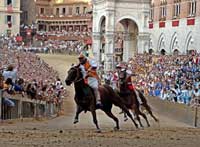 |
Podere Santa Pia |
|
Siena, Piazza del Campo
|
|
Siena, Palio |
| |
|
|
|
|
|
|
|
|
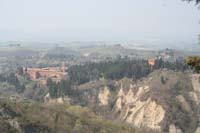
|
Bagni San Filippo |
|
L'eremo di Montesiepi (the Hermitage of Montesiepi)
|
|
Monte Oliveto Maggiore abbey
|
|
|
|
|
|
San Gimignano |
|
The abbey of Sant'Antimo |
|
Crete Senesi, surroundings
of Podere Santa Pia |
| |
|
|
|
|
The Park of Pratolino is one of the most beautiful parks in Florence surroundings. Even though the ancient Medicean villa and park has been destroyed, with just few monuments from that era remaining, it is easy to imagine its beauty and charm.
Among the monuments dating back to the Renaissance there is the massive statue of the Colossus of the Apennines by Giambologna (1579-80). The Apennines is made of stone and brick and had at one time grottoes decorated with frescoes and beautiful geometric decorations on the inside. The beautiful Chapel of Buontalenti has an hexagonal plan with a loggia; in the back, the last Demidoff princess has her final resting place. Then there are the Cupid's Grotto by Buontaltenti and the Fountain of Mugnone with Giambologna's statue.
There are also the Maschera Fishpond used as pool for hot baths, the large aviary and the impressive Fountain of Jupiter that used to be at the entrance into the Medicean park. Together with the neoclassical Lodge of Montili, these monuments can be visited only upon request. Guided tours, even during the week, can be booked by directly calling the park.
The park is a significant natural reserve, both for local flora and fauna. Within you'll find several centuries-old trees such as oaks, English oaks, cedars and conker trees and on a quiet stroll through the paths further away from the buildings it is easy to sight a few deer, foxes and hares in the vegetation before they quickly run away.
Today, the park of Pratolino is open to the public during weekends and holidays. Because of important restoration projects, only the central area of the park is generally accessible but other areas can still be visited by calling and booking ahead of time. Visits in this way can also be done during the week, all at no cost. We hope you enjoy visiting and exploring the park, taken a moment to imagine how it all was back in the time of the Medici.
History
Villa Demidoff is the current name of the ancient Medicean Paggeria of Pratolino. Located on the Florentine hills along the Via Bolognese heading into the Mugello valley, the estate in Pratolino was bought by Francesco I de' Medici in 1568.
Legend has it that Francesco bought it as a gift for his second wife Bianca Cappello with the idea of turning it into a fairy-tale property. The architect chosen to build the villa and turn this wild area into a dreamy place was Bernardo Buontalenti. He built a splendid Renaissance villa, which unfortunately is no longer in existence, surrounded by a wonderland park with water fountains and grottoes, beautiful gardens filled with exquisite plants and flowers. It was a small Versailles in Florence, a theater of delights, of magnificence and leisure.
The Park of Pratolino was the largest of the estates of the Medici family, as shown in a detailed view of the Villa by Giusto Utens at the Firenze Com'era Museum. It used to have a large Italian Renaissance garden, about 20 hectares wide, with a northern entrance in front of The Fountain of Jupiter. Within the park there were large stables, also used by travelers going along Via Bolognese.
When Francesco and Bianca suddenly died the park and the villa were abandoned by the Medici. It was Granduke Ferdinand III of Lorraine that brought back the park to new life. The Medicean villa was unfortunately destroyed and the park turned into a romantic garden, typical for that age.
In 1872 the park was sold to the Russian Prince Paolo II Demidoff, who restored the buildings within the property and enlarged one of the remaining outer structures into a villa that then took his name. The park was renovated, the layout remaining today. After 100 years, in 1981, the Florence Province Council bought the property to turn it into a public park.
How to reach Mugello
It is possible to reach Mugello through various roads and with various views. The quickest way into the area is with the Motorway A1 (Barberino di Mugello exit) while the most panoramic road into the area is through both the Faentina (SS 302) and Bolognese (SS 65) regional roads from Florence.
|
|
|
![]()
![]()
![]()
![]()





